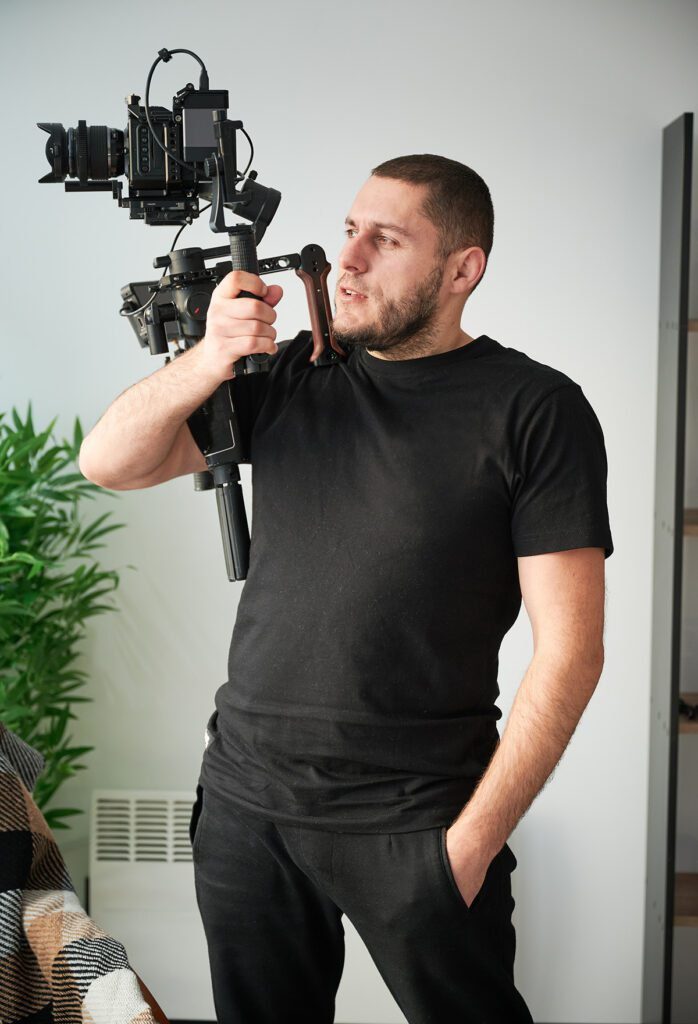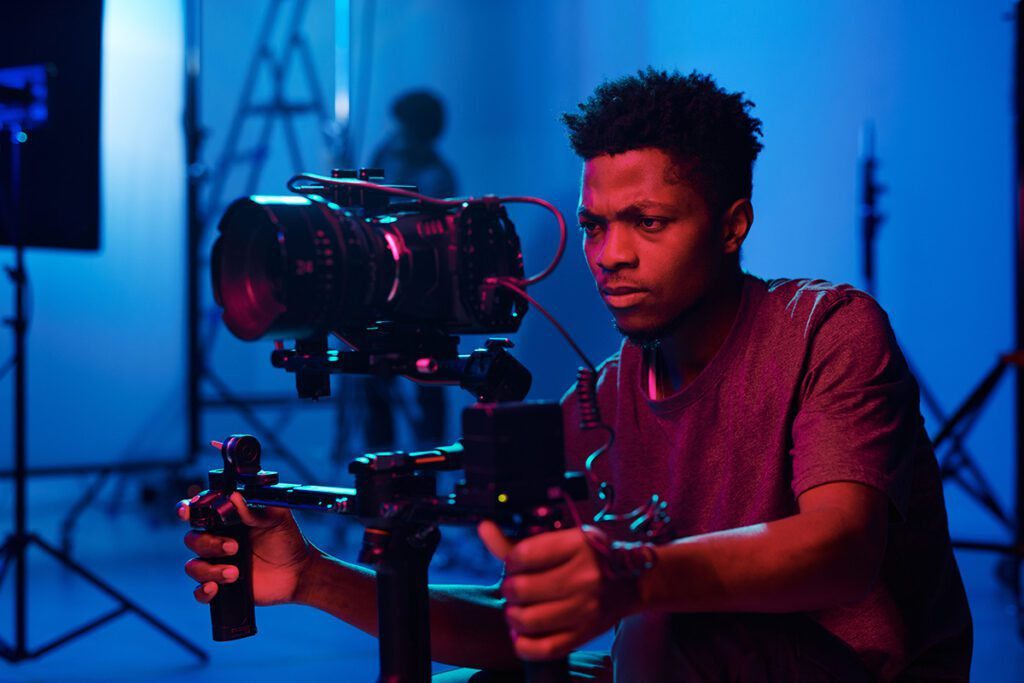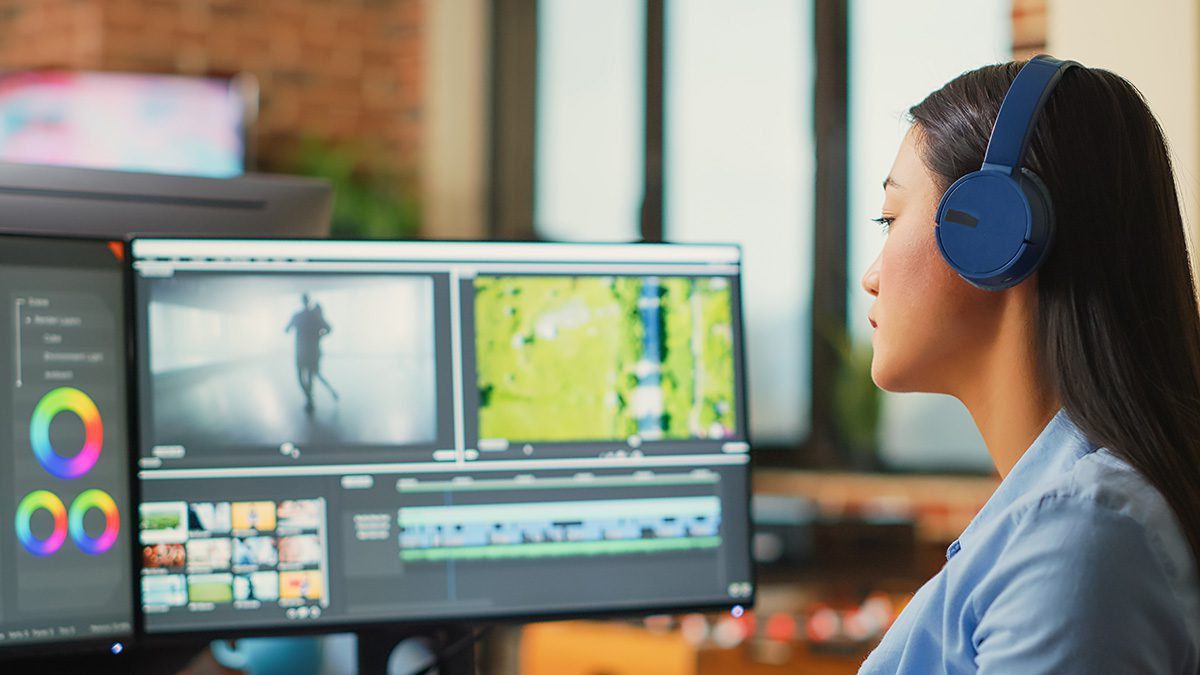The Great Visual Storytelling Debate: Videography or Cinematography?
Have you ever watched a stunning sunset in a movie and felt like you could almost reach out and touch the warm glow of the fading sun? Or how about feeling the palpable tension in a documentary, as if you’re standing right amidst the action? That, my friends, is the power of video. But not all video is created equal – some call it videography, others swear by cinematography. So, what sets them apart?
Welcome to Knotted Tree Studios, the heart of visual excellence in Central Texas, where we master the art of both videography and cinematography. Our lens has seen it all, from the first teary-eyed “I do” at sun-dappled weddings to the grandeur of cinematic epics that demand a silver screen. With cutting-edge gear and a crew that dreams in frames and thinks in sequences, we’re here to tell tales that stick.
In this article, we’ll dissect these two visual vocations. You’ll learn about the nuances and know-how that separate a videographer from a cinematographer. We’ll also illuminate how each craft contributes uniquely to the world of video. Whether you’re a bride-to-be, an indie filmmaker, or a business maven looking to catapult your brand into the spotlight, understanding this difference is key to choosing the right visual storyteller for your needs.
By the end, you’ll not only spot the difference between videography and cinematography but also know which one can turn your vision into breathtaking visuals. So, grab your popcorn (or your notepad) and let’s delve into the cinematic saga of videography versus cinematography – the Knotted Tree Studios way.
Understanding Videography: Capturing Life, Frame by Frame
When Every Detail Counts: Defining Modern Videography
Videography is the eye of the beholder in the digital age, capturing life’s moments as they unfold, with all their unpredictability and charm. It’s the craft of recording reality, whether it’s the chaos of a street festival or the choreographed dance at a wedding. In today’s world, videography is about storytelling with authenticity, giving viewers a front-row seat to the raw and real emotions of the narrative.
The Puppeteers Behind the Camera: Videographers at Work
A videographer is a jack-of-all-trades. They are the directors, the sound technicians, the light wranglers, and the editors, often all rolled into one. Armed with a keen eye for detail and a steady hand, videographers orchestrate the chaos into coherence. From planning shots to capturing spontaneous moments, their roles and responsibilities span the full narrative arc of production, delivering a polished final product that’s as true to the original moment as possible.
The Videographer’s Toolbox: Gearing Up for the Shoot
The typical arsenal of a videographer is both mighty and mobile. High-definition cameras, gimbals for that buttery smooth motion, drones for a bird’s-eye view, and lapel mics that capture the whisper of “I do” with crystal clarity. Each piece of equipment and setup is chosen with the foresight of a chess grandmaster, anticipating moves, and moments to capture the scene in its best light.
The Videographer’s Playground: A Spectrum of Projects
Ask a videographer what they shoot, and they’ll tell you: everything. Videography lends its lens to a diverse array of projects. From capturing the heartfelt vows at a wedding to the strategic branding in corporate videos, from the adrenaline rush of sporting events to the personal stories in documentaries, videography is the chameleon of the visual arts world, adapting to the color and contour of each unique story.
Storytelling with Soul: The Videography Narrative
The true art of videography lies in its ability to tell a story. It’s not just about recording images but weaving them together to create a narrative that resonates. Videographers are the modern-day bards, their cameras their quills, documenting tales not with ink, but with pixels and light. It’s a craft where every frame counts and every second tells a part of the story, stitched together to create a tapestry of visual memories.

Exploring Cinematography: The Art of Painting with Motion
Cinematography: Crafting Visual Poetry in Film
Cinematography is the alchemy of the film world, where light, shadow, motion, and color come together to create visual poetry. It’s the thoughtful composition of each shot, the deliberate choice of a lens, the intricate choreography of a camera’s movement—all to serve the story. In the world of film, cinematography doesn’t just set the scene; it breathes life into every frame, transforming scripts into immersive worlds that captivate the audience.
The Cinematographer: The Visual Maestro Behind the Scenes
If a film were an orchestra, the cinematographer would be the conductor, guiding the visual melody with precision and passion. Tasked with painting with light and shadow, the cinematographer collaborates closely with the director to shape the visual narrative. They are the architects of the film’s look, manipulating depth, perspective, and focus to evoke emotions and propel the story forward. This role is a blend of technical prowess and artistic vision, requiring a deep understanding of both the science of light and the language of film.
The Cinematographer’s Canvas: Tools of the Trade
Cinematography is an art form that demands high-caliber tools. Cameras with cinematic sensors, prime lenses that capture sharp yet beautiful images, cranes that swoop the audience into the action, and rigs that defy gravity—all these are part of the cinematographer’s canvas. Steeped in technology, from the latest digital cinema cameras to the revolutionary post-production color grading suites, the equipment in cinematography is as much about pushing boundaries as it is about capturing them.
Where Cinematography Shines: Projects with a Vision
Cinematography shines brightest in projects that dare to dream big. Blockbuster films with their epic scales, independent films that challenge norms, commercials that brandish sleek aesthetics, and music videos that weave visuals and sound into a single tapestry—all these are the playing fields for cinematography. It’s where ambitious concepts meet the visual expertise to make every frame a statement, every shot an opportunity to enchant.
Influencing Hearts and Minds: The Power of Cinematography
The influence of cinematography on the viewer’s experience is profound. It’s what makes the difference between watching a scene and living it. With its ability to manipulate time and space, cinematography pulls the audience into the narrative, inviting them to feel the suspense, revel in the beauty, or ponder the subtleties of the story. It’s an invisible hand that guides the viewer’s emotions, leaving an indelible mark on the canvas of their imagination.

Bridging the Visual Divide: Common Ground in Videography and Cinematography
Crafting Stories, Frame by Frame
Whether it’s the intimate glances exchanged in a wedding video or the grandiose vistas of a cinematic masterpiece, at the heart of both videography and cinematography lies the pulse of storytelling. Each discipline, in its own unique way, aims to thread a narrative that captivates and communicates, to turn the mundane into something magical. The shared goal is simple yet profound: to tell a story that deserves to be told, and to tell it well.
The Art of Composition: A Tale of Two Lenses
The visual composition is the canvas on which videographers and cinematographers both paint. Rule of thirds, leading lines, depth of field—these principles are universal languages spoken in the dialects of both fields. How a shot is framed, what is kept in focus, and what is blurred into bokeh are decisions that dictate the visual story being told, whether it’s in a quick-paced event highlight reel or a meticulously crafted film scene.
Emotion Through Imagery: The Universal Quest
Evoking emotions is the holy grail for both videographers and cinematographers. The laughter and joy in a birthday celebration highlight reel, the awe-inspiring moment a movie protagonist triumphs—these are not just seen; they are felt. The choice of color grade, the pacing, the angle of lighting—all are wielded with the intent to stir the hearts of the audience, to make them feel part of the journey.
A Symphony of Skills: The Intersection of Expertise
At the intersection of videography and cinematography is a shared skill set that binds practitioners of both arts. From an eye for the perfect shot to the technical know-how of camera operations, from the subtle art of editing to the precise control of lighting, the craftspeople behind the camera, regardless of their title, share a common foundation. It is their expertise that translates vision into visual, concept into creation.
In exploring the similarities between videography and cinematography, this section marries the two domains, emphasizing their shared objectives and artistic methodologies. It acknowledges that, regardless of the scale or scope, both crafts are about capturing life’s narratives and evoking emotions through the power of visual storytelling.

Diving into the Differences: The Distinct Paths of Videography and Cinematography
The Devil’s in the Details: Technical Tweaks That Tell Two Stories
Videography and cinematography may share the same alphabet, but they write very different stories. Technically speaking, videography often revels in the ‘run-and-gun’ approach, with equipment like DSLRs and mirrorless cameras that are agile and inconspicuous. Cinematography, on the other hand, is typically characterized by its use of high-end film cameras and an array of lenses designed to capture the director’s grand vision with precision. While videographers might harness natural light to document an event as it happens, cinematographers craft their scenes with an arsenal of lighting techniques to set the mood just right.
From Solo Acts to Orchestral Opuses: The Scale of Productions
The production scale in videography and cinematography is like comparing an intimate acoustic set with a full-blown symphony. Videographers often work solo or with a small team, adept at being nimble and capturing moments on the fly. Cinematography, conversely, is the domain of the grand – it’s a collaborative symphony where each department from art direction to sound design plays a critical role in the final piece. The scale is not just bigger; it’s multidimensional, bringing together a plethora of talents and visions to the silver screen.
Narratives Wide and Deep: Crafting the Story’s Canvas
The narrative in videography is often about capturing the essence of a moment or event, providing a snapshot that’s rich with authenticity. Cinematographers, meanwhile, have the luxury of depth and breadth in their storytelling canvas. They sculpt in time, with the latitude to explore complex narratives, characters, and worlds with a level of depth that turns storytelling into myth-making.
Audiences and Avenues: Tailoring Content for the Right Eyes
While videographers often produce content destined for the immediacy of social media, corporate events, or personal memories meant for a specific audience, cinematographers create visual feasts intended for the collective experience, be it theaters or on-demand platforms where stories are savored and discussed long after the credits roll.
Budgets and Resources: Balancing Indie Spirit and Blockbuster Ambitions
The fiscal landscape of videography and cinematography can be as contrasting as indie films and Hollywood blockbusters. Videographers are the maestros of making the most out of modest budgets, often pulling miracles with creativity as their currency. Cinematographers navigate larger-scale budgets, where the resources at their disposal are as expansive as their vision, allowing for a spectacle that transcends the confines of frugality.

Real-World Examples: Seeing is Believing in Videography and Cinematography
The Intimate Art of Videography: Moments That Matter
In the world of videography, the proof is in the poignant. Consider the wedding videographer who captures not just the exchange of vows but the hopeful glances, the tearful parents, the joyous dance moves – all with a handheld camera that weaves through the crowd. Move over to the polished floors of corporate events, where videographers encapsulate the essence of brand launches and keynote speeches, making sure the company’s message is not just heard, but felt. And let’s not forget the real estate virtuoso, whose drone and steadicam tours give life to still homes, turning empty rooms into dream homes with smooth walkthroughs and cinematic reveals.
Cinematography: The Grand Visual Symphony
Now, enter the realm of cinematography, where the canvas is as broad as the director’s vision. The feature film that takes you on a journey through fantastical worlds, each frame meticulously composed to transport you into the story. The high-end commercial that feels less like an ad and more like a 30-second feature film, with cinematic lighting and visual effects that elevate a product to an experience. Or the television drama that keeps you on the edge of your seat, not just with its cliffhangers but with its visual depth, its shadows and light playing just as much a part in the storytelling as the actors themselves.
A Visual Comparison: The Tale of Two Techniques
When you place videography and cinematography side by side, the visual elements tell a tale of two techniques. The videographer’s work is immediate, full of life and spontaneity, where the aim is to capture the moment as it is, candid and authentic. The cinematographer’s frame, by contrast, is deliberate, sculpted with light, color grading, and composition to not just show but to evoke and to imply. One is a documentary of the here and now, the other a crafted narrative inviting you to a different reality.
Choosing the Right Approach for Your Project: A Tailored Visual Strategy
Deciphering Your Needs: Videography or Cinematography?
Every visual tale calls for a distinct approach, and deciding between videography and cinematography is the first crucial step in the storytelling journey. Factors to consider include the nature of the project, its intended scale, and the depth of the story you wish to weave. If your project is event-driven, candid, and requires a personal touch, videography is your go-to. It’s perfect for those moments that need to be caught on the fly, with authenticity and a genuine spark. On the flip side, if your project is ambitious, seeks to explore the depths of narrative storytelling, and requires a crafted visual aesthetic, cinematography will be your ally in creating that immersive experience.
Tuning Into the Audience’s Frequency
Understanding your audience is akin to choosing the right spices for a dish; it’s what turns good into great. Are your viewers looking for a quick, engaging story that speaks to their personal experiences, or are they in search of a visual journey that takes them beyond the edge of their seats? The former leans towards the relatable immediacy of videography, while the latter demands the immersive depth that cinematography offers.
Knotted Tree Studios: Your Vision, Our Visual Craftsmanship
At Knotted Tree Studios, we pride ourselves on not just capturing images, but on capturing your vision. Our expertise lies in understanding your story’s heart and selecting the right visual language to tell it. With our finger on the pulse of the latest trends and technology, we guide you through the decision-making process, ensuring that the approach we take not only aligns with your vision but also resonates with your audience.
Whether it’s preserving the magic of personal milestones through videography or crafting a cinematic piece that demands the world’s attention, our team at Knotted Tree Studios stands ready to transform your ideas into visual masterpieces. We don’t just produce content; we produce memories, experiences, and stories that linger long after the screen fades to black.

The Final Cut on Videography and Cinematography
Capturing Life, Crafting Epics: Your Visual Anthology Decoded
As the final reel runs and the credits are set to roll, let’s recap the essential frames of our discussion. Videography stands out in its ability to capture life’s spontaneous moments with authenticity and personal flair. It’s intimate, it’s in the moment, and it’s utterly real. Cinematography, in its grandeur, sculpts light and shadow to craft narratives that enthrall and captivate. It’s about creating a world beyond the lens, one that draws the audience into its embrace and leaves them in awe.
Knotted Tree Studios: Masters of the Visual Arts
Knotted Tree Studios emerges as a beacon of visual storytelling, where the expertise in both videography and cinematography converges to offer you nothing short of brilliance. Our arsenal is not just our state-of-the-art technology; it’s the passion, the precision, and the creative vision that our team brings to every project. We are the storytellers, the light wranglers, the color weavers, and the detail obsessives who ensure that your story is not just told but is felt, remembered, and cherished.
Your Story Awaits: Let’s Tell It Together
Whether it’s the whispers of love exchanged in a glance or the echoes of an epic across the cinemascope, your story is waiting to be told. And who better to entrust with your narrative than Knotted Tree Studios, where your vision meets the zenith of visual storytelling? Reach out to us, and together, we’ll script the next chapter of your journey in the dialect of videography or the language of cinematography—whichever tells your story best.
 We all intend to plan ahead, but too often let the day-to-day minutia get in the way of making a calendar for the year. Sure, you can’t know every detail to anticipate. Heck, you can’t know half the priorities
We all intend to plan ahead, but too often let the day-to-day minutia get in the way of making a calendar for the year. Sure, you can’t know every detail to anticipate. Heck, you can’t know half the priorities 
Recent Comments